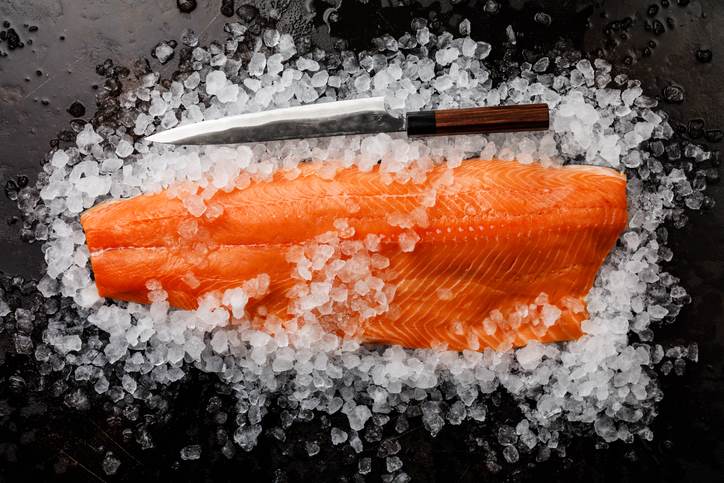Christmas & New Year Trading
Website: Open 24/7 for on-line ordering.
Customer Service/Warehouse: Closed 12pm Monday 23rd December 2024, re-opening 8:30am Thursday 2nd January 2025.
All orders placed over the holiday period will be processed in the New Year.
We wish all of our customers a Merry Christmas and a Happy New Year.
Types of kitchen knives: best knives for professional chefs
Knives are a crucial tool for any chef. A knife’s design, composition and effectiveness can change depending on where in the world it comes from. With the hundreds of manufacturers available, it can be hard to know which knife to choose for your professional kitchen.
In this guide, we give an explanation of the types of kitchen knives available, their benefits and how to maintain them.
In this guide
If you’re simply looking for the best knives to buy, you will find key information and prices on our guide: best kitchen knives.
Types of kitchen knives
This section will showcase the main types of kitchen knives a professional chef will be using in their kitchen.
The types of kitchen knives include:
- Boning knives
- Filleting knives
- Carving knives
- Sushi and sashimi knives
- Paring knives
- Pastry knives
- Chef's knives
- Cleavers
- Utility knives
- Salmon knives

Boning knives
Boning knives have long, thin, flexible blades with a sharp tip. They are designed for removing bones easily and efficiently by cutting through ligaments and connective tissue.
The main requirement for a boning knife is to be extremely sharp. Dull blades will rip meat from the bone which affects presentation and can also pose a health hazard. A sharp blade will slice meat with ease.
Bone knife blade design
Boning knives have long, thin, flexible blades with a sharp tip. They are designed for removing bones easily and efficiently by cutting through ligaments and connective tissue.
- Thin – thinner blades travel through flesh with less resistance, which is useful for delicate meat. Thin blades are often needed for smaller bones such as fish.
- Broad – broad blades are generally wider and sturdier which is useful for portioning thick sections of meat
- Stiff – tougher and thicker meat such as tough lamb requires stiff blades. Stiff blades can be used to cut through and portion wide cuts without going off course.
- Flexible – flexible blades are better for more intricate jobs with tender meat. The flexibility allows the knife to cut around difficult shapes and lighter corners
- Straight – removes large chunks of meat, such as beef, with ease.
- Curved – curved blades are excellent at removing fish skin in one swipe. Curved blades are also useful for delicate jobs as the angle of the curve offer easier manoeuvrability around small spaces.
To find out more about bone knives, visit:

Filleting knives
A filleting knife is designed specifically for fish. Its blade is thin and flexible enough to separate meat from the bone but strong enough to cut through small bone when necessary.
The main tasks of a fileting knife are:
- Filleting – cutting the fish into boneless strips
- Skinning – removing the skin of a fish
- De-boning – removing the bones of a fish
Filleting fish tips
- The larger the fish, the longer your filleting knife blade needs to be. Fillet knives are available from 10cm – 23cm with 20cm being the average.
- Fillet fish aren’t normally used when prepare sushi – sashimi or sushi knives are used instead.
- Tweezers are excellent at removing pin bones from the fish, whilst scissors can easily remove the fins.
To find out more about filleting knives, visit:

Carving knives
Carving knives can be a confusing term. Some people refer to carving knives as slicing knives (or slicers). Just understand that this is a catch-all term and are referring to the same knife. Carving knives are designed to cut meat (slicing). There is a long history of carving knives dating all the way back to the times of knights and chivalry. You can find out more about the history of Carving knives by visiting our guide: know your carving knife history.
Carving knives come in three distinct styles:
Rounded tip
- The rounded tip is a safety feature to avoid accidents
- Often longer and more flexible
- The straight edge aids long and even strokes
Pointed tip
- Designed for meat that has been cooked on the bone
- The pointed tip is used to separate the slice from the bone
Granton-style edge
Granton-style edge knives feature scalloped edges (also known as fluted or hollow edges). The scalloped edges create a thin sharp edge on one side that is reinforced by the sections of the knife that is not scalloped. Granton-style edge carving knives are extremely sharp whilst remaining strong.
As the meat is sliced, air pockets are created in the scalloped edges that stop the meat from falling apart, improving presentation. Juices can also fill these pockets which creates a low-friction effect that works well when trying to slice thin pieces if ham or poultry.
Granton Edge knives are only manufactured by Granton Knifemakers in Sheffield. You can find out more by visiting our guide: Frequently asked questions about Granton Edge Blades
To find out more about carving knives, visit:

Sushi and sashimi knives
Sushi and sashimi knives are based on centuries of tradition and skill. There are a wide variety of sushi knives available, each designed for a specific job. Use the table below to find out about the main knives used when preparing sushi/sashimi.
Types of sushi/sashimi knives and their uses
| Knife type | Used for... |
|---|---|
|
Deba bōchō |
Carving portion of fish and cutting through fish bones |
|
Santoku |
Cutting through fish, vegetables and nori rolls |
|
Yanagi sushimi |
Producing delicately thin slices of fish |
|
Tako sushimi |
Slicing octopus and other seafood |
What is the difference between sushi and sashimi knives?
There is no difference, as they are both used to prepare raw seafood. The difference is in the way the seafood is presented:
- Sushi must contain vinegar-infused rice for it to be classed as sushi.
- Sashimi is simply thin slices of raw seafood which is either plain or flavoured.
To find out more about sushi/sashimi knives, visit:
Nakiri bōchō knives
Nakiri bocho knives are traditional Japanese vegetable knives which are often used simultaneously to sushi knives. They differ from the deba bōchō as they are much thinner, designed to cut through vegetable without the need for a horizontal pull or push.
Japan is considered one of the most important centres of the world’s kitchen knife industry. It produces some of the most sought-after knives in the world. The Japanese city of Seki is home to the manufacturer of the world-renowned Shun knife range. You can find out more by visiting our guide: Shun knives FAQ.
Paring knives

Paring knives (also known as peeling knives) are incredibly versatile and should be included in every professional kitchen. It can be used in a variety of situations. Because of this, some people confuse paring knives for chef knives or standard utility knives. It’s important to differentiate, which you can find below.
What is a paring knife?
A paring know is a short, versatile knife with a blade length of 8 – 10 centimetres (3 – 4 inches). This makes it smaller than standard chef knives and therefore useful for more precise cutting, trimming or slicing.
What are paring knives used for?
| Vegetables | Fruit | Meat and fish |
|---|---|---|
|
|
|
To find out more about paring knives, visit:
Paring knives buying guide – find the best paring knife for you
Pastry knives

Pastry knives should be a key tool for any professional baker. They are versatile, and are able to double as a palette knife or spatula with a broad blade to the tip. The blade is also serrated which is designed to be more flexible than a standard chef’s knife.
How to tell a pastry knife:
- Serrated edge – a serrated knife can cut through any hard-baked pastry cuts. The serrations helped when portioning delicate sponges and pastries.
- Long blade – makes cutting large cakes, pies or pastries easy. Can also lift rolled pastry from a board. And make horizontal cuts through sponge.
- Wide blade – used to spread icing, jam and other fillings as well as move rolled pastry
- Rounded tip – helps remove cakes and pastries from baking pans without damaging the outer layer.
Pastry knives vs bread knives
Bread knives and pastry knives are similar and people often double up the usage depending on which knife they have in their kitchen. However, there is one key difference between the two - the tip of the blade.
- If your knife has a sharp tip – it is a bread knife.
- If your knife has a broad tip - it is a pastry knife. The broad blade allows the knife to be used as a spatula or pallet.
To find out more about pastry knives, visit:
Chef's knives

A chef’s knife (also known as chef knife) is one of the most versatile knives available. It’s often the ‘go-to’ knife for many professional chefs. It has a broad and sharp blade with a slight curve from the heel to the tip of the blade. Chef’s knives can be used for a variety of purposes, including:
- Cutting meat
- Dicing vegetables
- Slicing herbs
- Disjointing some cuts
You may find your chef knife getting a lot of use. It’s essential you take care of your chef knife. You can find out the 10 most common chef knife care mistakes by clicking here.
Chef knives or Santoku knives?
Santoku knives are similar to chef’s knives and equally as versatile. The full name for Santoku knives is Santoku bocho which translates as ‘three uses’ and are ideal for mincing, dicing and slicing.
Chef’s knives are generally made in either France of Germany whilst Santoku knives are made in Japan. You can find out more about the differences between German steel and Japanese knives by visiting our guide: Japanese vs German knives.
Whilst chef’s knives and santoku knives are similar, they aren’t identical. The table below will showcase the differences between the two.
Chef’s knives vs Santoku knives
| Chef's knife | Santoku knife | |
|---|---|---|
|
Blade length |
|
|
|
Blade material |
|
|
|
Blade qualities |
|
|
|
Handle |
|
|
|
Uses |
|
|
To find out more about santoku and chef knives, visit:
Cleavers

A cleaver is a large knife that is usually known for its rectangular shaped blade, similar to a hatchet. It’s designed to hack through small/medium bone.
Unlike most kitchen knives, Cleavers often have a tough edge to give it extra robustness. Cleavers need to be able to withstand repeated blows into thick mean, cartilage or bone. Cleavers are designed to be swung like a hammer, with the force and the weight of the cleaver helping chop straight through.
Utility knives
Utility knives are sized between a chef’s knife and a paring knife. They are a versatile general-purpose tool designed to carry out everyday tasks. You can often by a group of vary sizes in a single knife set.
Utility knives can used for:
- Cutting cheese
- Slicing meats
- Cutting fruit and vegetables
- Slicing sandwiches

Salmon knives
Salmon knives have long, narrow blades designed to cut thin, even slices of salmon. The blade is extremely flexible with a rounded point to prevent any damage to the salmon. Some salmon knife blades have clefts to stop the salmon from sticking to the blade, making it easier to cut thin, perfect slices.
Sharpening your knives
Keeping your knives sharp offers many benefits as they are an important piece of equipment. These benefits include:
- Fast work – easier chopping with less mistakes
- Greater control – Food can be sliced thinly, with sharp knives gliding through food
- Less food damage – Less chance of squashing
- Safer – Less pressure is applied to less chance the knife will go astray
There are 3 main ways to sharpen knives:
- Steel sharpener
- Whetstone
- Tabletop sharpener

Steel sharpener
A steel sharpener is the most common way for sharpening knives. Steel sharpeners are often flat, oval or round in the cross section. They are mostly used in the west, most commonly in heavy-use scenarios such as butchering.

Whetstone
Whetstone (also known as a sharpening stone) are made of various materials including diamond or ceramic. Whetstone grit is what sharpens the knives – the more grit, the sharper the blade can get. Whetstone is often used in Japan for sharpening knives due to the higher level of control it offers. Whetstone also removes less of the blade’s material than other methods.

Tabletop sharpener
Tabletop sharpener are a quick and easy way to sharpen kitchen knives. They can be used in an instant during service.
Further reading
16 January 2020





